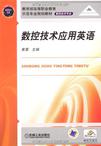数控技术应用英语
出版时间:2009-1 出版社:机械工业出版社 作者:黄星 主编 页数:230
前言
《数控技术应用英语》是专业英语阶段的教材,旨在提高数控类专业学生专业英语水平及满足其一般交际的需要。 本书是依照《高职高专教育英语课程教学基本要求(试行)》的标准,从培养高级应用型人才的总体目标以及高职教育教学实际出发,结合学生毕业后的工作实际,力求为学生提供未来工作岗位所必需的专业英语知识,培养学生在实际工作岗位应用专业英语的能力而组织编写的。 全书共设10个单元,每个单元都由阅读与翻译、模拟套写与实际训练等几部分内容组成,以与企业紧密结合的英语实用性文章或具体实例来编写,同时配有与数控知识相关的实用英语对话。 本书是以就业为导向,以提高学生的职业能力和职业素质为目的,结合专业英语的特点而编写的数控技术专业英语,突出数控专业的词语和用法,以典型数控系统的操作、维修、诊断和编程英文说明书为主要参考,以英文阅读理解、翻译和资料查询为重点,使学生获得阅读和查阅数控机床、数控系统操作与编程说明书等的能力。 本书共设10个单元,供一个学期使用。每个单元主要包括四部分内容: 第一部分为“专业阅读”(Technical and Practical Reading),旨在培养学生数控专业英 语的阅读能力,包括两篇文章,展示当今高、新数控机床及加工工艺等,同时附有一些真实景的数控实践方面的照片等,每篇字数控制在500~650字。 第二部分为“了解控制面板”(Glance at a Control Panel),它可以帮助学生了解数控机床操作面板中各键的功能及应用,是应用性很强的必学内容。 第三部分为“模拟套写”(Simulated Writing),包括两部分内容:Section A为“常见数控故障诊断” (Common Failure Diagnostics);Section B为“试试您的动手能力” (Have a Try),为小零件数控程序设计。同时还配有相应的套写、拟写,翻译简单的产品广告、机床说明书、数控系统操作与编程说明书等应用文。 第四部分为“交际会话”(Communicative Speaking),选用贴近实际、贴近企业、贴近生产的常用专业英语会话,以便进行口头交际能力的训练等。 本书构思力求实用为先,特色鲜明,贴近企业,贴近专业,重点突出和针对性强。尤其是对课文以外部分的“练习”内容的编排,着重突出专业英语的特色,设计独创,采取一种全新的方式,让学生通过“练习”,既能学到英语,又能学到数控专业的各类小知识,可谓一举两得。 长春汽车工业高等专科学校黄星任本书主编,北京林业大学外语学院蒋耀熠任副主编。黄星编写了第1、2、3单元,蒋耀熠编写了第4、5、6单元,长春汽车工业高等专科学校赵九九编写了第7、8、9、10单元。 本书由中国一汽集团公司机动处(蓝迪公司)机器人部部长黄晶高级工程师主审,他在机床设计及制造方面有很高的造诣,为本书提供了部分专业素材,并在编写过程中提出了许多专业方面的建议,对全书进行了审核。 本书在编写过程中还得到了刘万菊教授、刘永久、王伟罡等专业老师的大力支持,他们提出了许多宝贵意见和建议,还提供了大量的数控技术方面的最新资料,使得本书能够顺利完成。在此,编者对他们的热情帮助以及无私奉献深表谢意。 为满足广大专业读者的需求,本书在兼顾英语习惯的通用性和特殊性的基础上突出体现了数控技术的专业性,但由于时间仓促,加之编者水平有限,书中不当之处在所难免,恳请广大专家、读者批评指正,在此深表感谢。
内容概要
本书为教育部高等职业教育示范专业规划教材,是专业阶段的英语教材,旨在提高高职高专院校数控技术专业学生和数控技术从业人员的专业英语水平,以及涉外业务人员韵交际能力。
本书是依照高职高专教育培养目标及教学实际,遵循“边学边用,学用结合”的原则编写的,内容全面、实用、先进、通俗易懂,难点、重点突出,贴近企业,贴近实际。
全书包括10个单元,每个单元都有与企业紧密结合的实用例题,还安排有数控实用英语对话等。
本书既可作为高职高专、成人高校数控技术、机电一体化等专业的专业英语教材,也可用作企业培训教材,或供相关技术人员学习参考。
书籍目录
前言
Unit 1 History of NC and CNC
Part Ⅰ Technical and Practical Reading
Passage A:History of Numerical Control
Passage B:History of Computer Numerical Control
Part ⅡGlance at a Control Panel
Part Ⅲ Simulated Writing
Section A Common Failure Diagnostics
Section B Have a Try
Part Ⅳ Communicative Speaking:Meeting Cust omers at the
Airport
Unit 2 Introduction to CNC.
Part Ⅰ Technical and Practical Reading
Passage A:Buttons and Switches Found on the Control Panel
Passage B:The Fundamentals of CNC
Part ⅡGlance at a Control Panel
Part Ⅲ Simulated Writing
Section A Common Failure Diagnostics
Section B Have a Try
Part Ⅳ Communicative Speaking:Discussing the Schedule
Unit 3 Operation Principle of CNC
Part Ⅰ Technical and Practical Reading
Passage A:CNC Work—An Introduction
Passage B:Features of CNC
Part ⅡGlance at a Control Panel
Part Ⅲ Simulated Writing
Section A Common Failure Diagnostics
Section B Have a Try
Part Ⅳ Communicative Speaking:Visiting a Plant of CNC
Machine
Unit 4 CNC Programming Techniques
Part Ⅰ Technical and Practical Reading
Passage A:Bracket Arm Tutorial
Passage B:CNC Part Programming
Part Ⅱ Glance at a Control Panel
Part Ⅲ Simulated Writing
Section A Common Failure Diagnostics
Section B Have a Try
Part Ⅳ Communicative Speaking:Entertaining Customers
Unit 5 Operation of CNC Machines
Part Ⅰ Technical and Practical Reading
Passage A:Operations of CNC Machine Tools
Passage B:Aluminurr/Enclosure Tutorial
Part ⅡGlance at a Control Panel
Part Ⅲ Simulated Writing
Section A Common Failure Diagnostics
Section B Have a Try
Part Ⅳ Communicative Speaking:Issuing the Information About New
Product
Unit 6 Introduction to Robotics.
Part Ⅰ Technical and Practical Reading
Passage A:A History of Robotics
Passage B:Types of Robots
Part ⅡGlance at a Control Panel
Part Ⅲ Simulated Writing
Section A Common Failure Diagnostics
Section B Have a Try
Part Ⅳ Communicative Speaking:Public Relation Activity
Unit 7CNC Maintenance and Training
Part Ⅰ Technical and Practical Reading
Passage A:CNC Machine Maintenance
Passage B:CNC Training Guidelines
Part ⅡGlance at a Control Panel
Part ⅢSimulated Writing
Section A Common Failure Diagnostics
Section B Have a Try-
PartⅣCommunicative Speaking:Maintenance of CNC Machine Tools
Unit 8Operating Instruction of CNC
Part Ⅰ Technical and Practical Reading
Passage A:Uniport 8000 Traveling Bridge CNC Machining
Center
Passage B:Advantages and Disadvantages of CNC Machines
Part ⅡGlance at a Contml Panel
Part ⅢSimulated Writing
Section A Common Failure Diagnostics
Section B Have a Try
PartⅣCommunicative Speaking:After—Sales Service
Unit 9IntrOductiOn 0f 2D and 3D Computer-Aided Design
Part Ⅰ Technical and Practical Reading
Passage A:2D Computer—Aided Design and Manufacture
Passage B:3D Computer-Aided Design and Manufacture
Part ⅡGlance at a Control Panel
Part ⅢSimulated Writing
Section A Common Failure Diagnostics
Section B Have a Try
Part ⅣCommunicative Speaking:Talking About 2D and 3D
Unit 10 CNC Machines and Safety
Part Ⅰ Technical and Practical Reading
Passage A:Safety Features of CNC Maehines
Passage B:Safety Precautions of CNC Machines
Part ⅡGlance at a Control Panel
Part ⅢSimulated Writing
Section A Common Failure Diagnostics
Section B Have a Try
Part ⅣCommunicative Speaking:Talking About CNC Supervising Safety
Glossary
List of Abbreviations
参考译文及练习答案
章节摘录
computer to receive its instructions without the use of any intermediate medium·In addition,the.controller could be fitted with its own keyboard for directly entering the program,called Manual Data’Input(MDI).Whatever the method for instructing the controller,the controller could then executethe program by reading from its own memory. Debugging an NC program before the advent of CNC required making a new tape,trying out thenew tape,finding the next error,making another tape,and SO on.The process of debugging a newprogram could require making a dozen or more punched tapes until an error free program was a-chieved.Engineering changes required a new tape to be made and debugged. The introduction Of CNC.with the NC program stored in the controller’S memory,made itpossible to access the program directly in the controller’S memory,making all the needed changes by keying in from the controller’s keyboard f Figure 1-7.The front panel of a CNC controller).When theprogram is finally debugged,the CNC controller canbe connected to a punched tape or other recordingdevice to output the edited program,to be saved forfuture use. The microprocessor chip is a kind of computer-一a special-purpose computer.Hence such NC machines came to be known as computerized NCs-or CNCs.The canned cycle circuit boards were de-signed into the microprocessor chips and made a lit-tie fancier by adding still more canned cycles,suchas peck drilling for deep holes.rectangular and cir-cular pocket milling,and even routines to calculate and drill boh Circle patterns(Figure 1·8.The small microcircuit in the center contain more functions.
图书封面
评论、评分、阅读与下载
用户评论 (总计2条)
- 帮了我毕业设计的大忙
- 比较适合提高专业英语
